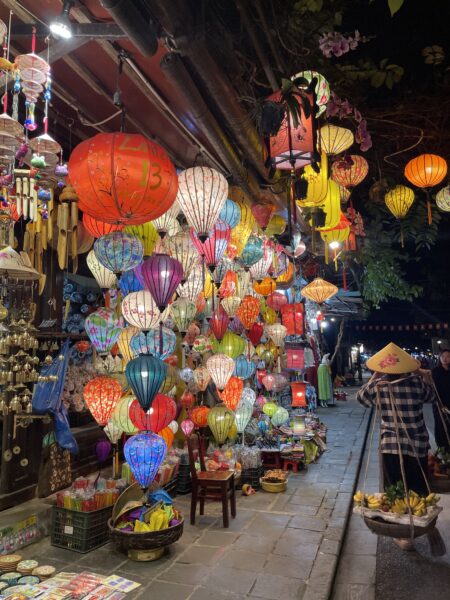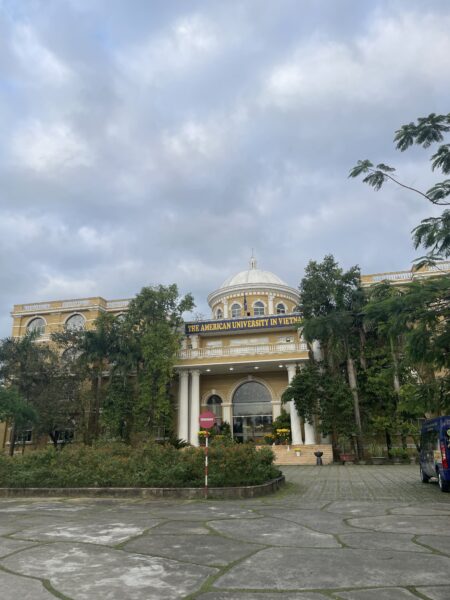Column: Abroad in Vietnam, arriving in Da Nang

A street-front store sells lanterns in the historic city of Hoi An.
As of this week, we have officially arrived at our home base in Da Nang. We will stay here for the next seven weeks, studying and taking classes with our USU professors at the American University in Vietnam and seeing as much of the city as we can. For now, our arrival could not have come at a better time — we are all due for a long nap and a load of laundry!
After two weeks of non-stop excursions and learning, settling down, unpacking and having some comfort food was just what we needed. Don’t get me wrong, the food in Vietnam is incredible, and we have eaten so many new and exciting meals, but it can be hard on your stomach after a few weeks of continuous culinary novelty. The university provided some spaghetti and chicken nuggets when we got here, and I think it’s safe to say we were stoked. We moved into our new dorm, met some of the girls down the hall and enjoyed our first night in our new home.
The next day, we drove to the area around Hoi An, just south of Da Nang, and sat at the beach for a few hours. The sun has made a few rare appearances, so that was one of only two days we were able to go to the beach this week. We are itching to see all the beaches around us and find a place to call ours for the next month and a half.

Our first look at the American University in Vietnam in Da Nang.
We did, however, get the opportunity to go back to Hoi An and experience the city a few days later. According to UNESCO, the city of Hoi An appeared on the map in the 15th century and began as a trading port between Southeast Asian countries. It has a long history of silk production, fabric trading and tailoring and has continued those traditions throughout the years, creating a place of heritage and authenticity.
This history is prevalent in the colored lanterns that hang from spandrel to spandrel in the skinny, crowded streets, in the tailors and street vendors calling out greetings from little red stools along the road and the smell of banana pancakes and coffee drifting along the river as you walk towards the sea.
The rich culture in Hoi An is beautifully overwhelming. The ancient city has been so well preserved you get a taste of its history in every alleyway and stall. I would go back a thousand times to witness it again and again. There is always something new to be found in Hoi An. It is the type of place you find a way to make your own in some way.
It was also apparent in our time there I was not the only person who thought that. Everywhere we went, restaurants, businesses and shops were crowded with tourists from every corner of the globe trying to capture a glimpse of the historic city. Boats filled to the brim with tourists making their way along the river all day long. Vietnamese dong, the currency here, flies out of pockets and purses in exchange for souvenirs, custom clothing and happy hour drinks. The city thrives off tourism, and the tourists thrive off the city.
The tourism industry itself has taken off, not only in Hoi An but throughout Vietnam as well. An article from Vietnam News suggests many localities are reporting millions of dollars from tourism revenue every year, especially during the Lunar New Year holiday, or Tet Nguyen Dan in Vietnam. From what we have learned, tourism has been an invaluable source of income for many families and can help preserve places like Hoi An by providing income without destroying tradition. This system allows the city to remain intact and for people like me to still have the chance to walk along its streets.
As I write this, I am overwhelmed by gratitude and appreciation for our experiences so far in Vietnam. Already, I am harboring a deep love for this country I cannot describe or explain. From Ho Chi Minh City to Can Tho to Da Nang, we have been on a lifetime’s worth of journeys, and we are only barely getting started.
It has been a joy to share a little bit of my love for Vietnam and our journeys with you here on these pages. I am looking forward to spending more time in Da Nang and sharing some of the aspects of our reading and classwork with you. Next week, we are traveling to My Son, landmark of ancient temples and ruins, to see what Vietnam looked like 1,000 years ago. As always, hẹn gặp lại!
P.S. That means “See you soon!”

